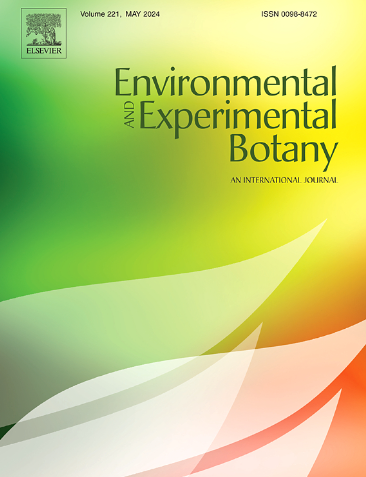对花生中含有 MYB 转录因子的两个重复序列进行全基因组分析,确定了作为根瘤负调控因子参与其中的干旱诱导基因
IF 4.5
2区 生物学
Q2 ENVIRONMENTAL SCIENCES
引用次数: 0
摘要
MYB 基因超家族包括一组存在于所有真核生物中的相关基因。与动物不同,高等植物中含有大量的双重复 MYB 基因,这些基因在调控重要的发育、生物和非生物胁迫反应方面已经得到证实,这些反应对植物的产量有着深远的影响。然而,关于花生及其祖先的双重复 MYB 基因家族的全面分析,特别是双重复 MYB 基因在干旱胁迫响应中的作用以及这些基因在结瘤中的影响,迄今尚未见报道。我们最近对落花生基因组的分析发现了 79 个(Arachis duranensis)、84 个(Arachis ipaensis)和 161 个(Arachis hypogaea)双重复 MYB 基因,这些基因根据其结构属于多个不同的亚群。在此,我们对这些基因的结构、蛋白基序组织、染色体定位、基因重复事件和同源关系分析进行了全面概述,以阐明其进化前景。同一亚群的成员表现出高度保守的结构和主题组成。全基因组复制和节段复制可能是双重复MYB基因在Arachis hypogaea中扩增的原因。大多数基因的上游序列包含植物激素响应、胁迫响应、光响应和植物生长相关元件。这些基因不仅在不同的生长发育阶段有不同的表达谱,而且正如我们的实验结果所显示的那样,它们中的大多数都受到 ABA 和干旱相关胁迫的诱导。进一步的基因沉默实验表明,两个干旱诱导的 MYB 基因(拟南芥 MYB96 和 MYB94 的同源基因)是根瘤的负调控因子。本研究的结果为进一步阐明花生中两个重复的 MYB 基因的生理和分子功能奠定了坚实的基础。本文章由计算机程序翻译,如有差异,请以英文原文为准。
Genome-wide analysis of two repeats containing MYB transcription factors in groundnut identifies drought-inducible genes involved as a negative regulator of root nodulation
The MYB gene superfamily encompasses a group of related genes found in all eukaryotes. In contrast to animals, higher plants contain large numbers of two-repeat MYB genes, which have been established in regulating crucial developmental, biotic, and abiotic stress responses that profoundly affect the plant's yield. However, a comprehensive analysis of the two-repeat MYB gene family in groundnut and its progenitors, especially the role of two-repeat MYB genes in response to drought stress, and the effect of those genes in nodulation have not been reported so far. Our recent analysis of the groundnut genome has identified 79 (Arachis duranensis), 84 (Arachis ipaensis), and 161 (Arachis hypogaea) two-repeat MYB genes, which belong to multiple distinct subgroups based on their architecture. Here, we provided a complete overview of the gene structure, protein motif organization, chromosome localization, gene duplication events, and synteny analysis to clarify evolutionary perspectives. Members of the same subgroup showed highly conserved structure and motif compositions. The whole-genome duplication and segmental duplication likely contributed to the expansion of two-repeat MYB genes in Arachis hypogaea. The upstream sequences of most genes contained phytohormone-responsive, stress-responsive, light-responsive, and plant growth-related elements. The genes not only have diverse expression profiles across different development stages but as shown in our experimental findings, most of them were induced by ABA and drought-related stress. Further gene silencing experiments demonstrated that two drought-inducible MYB genes, homologs of Arabidopsis MYB96 and MYB94, function as a negative regulator of root nodulation. The results of this study can serve as a strong foundation for further elucidation of the physiological and molecular function of two-repeat MYB genes in groundnut.
求助全文
通过发布文献求助,成功后即可免费获取论文全文。
去求助
来源期刊

Environmental and Experimental Botany
环境科学-环境科学
CiteScore
9.30
自引率
5.30%
发文量
342
审稿时长
26 days
期刊介绍:
Environmental and Experimental Botany (EEB) publishes research papers on the physical, chemical, biological, molecular mechanisms and processes involved in the responses of plants to their environment.
In addition to research papers, the journal includes review articles. Submission is in agreement with the Editors-in-Chief.
The Journal also publishes special issues which are built by invited guest editors and are related to the main themes of EEB.
The areas covered by the Journal include:
(1) Responses of plants to heavy metals and pollutants
(2) Plant/water interactions (salinity, drought, flooding)
(3) Responses of plants to radiations ranging from UV-B to infrared
(4) Plant/atmosphere relations (ozone, CO2 , temperature)
(5) Global change impacts on plant ecophysiology
(6) Biotic interactions involving environmental factors.
 求助内容:
求助内容: 应助结果提醒方式:
应助结果提醒方式:


